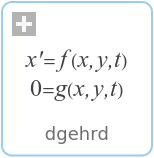WOLFRAM SYSTEM MODELER
dgehrdReduce a real general matrix A to upper Hessenberg form H by an orthogonal similarity transformation: Q' * A * Q = H |
|
Wolfram Language

SystemModel["Modelica.Math.Matrices.LAPACK.dgehrd"]

Information
This information is part of the Modelica Standard Library maintained by the Modelica Association.
Lapack documentation
Purpose
=======
DGEHRD reduces a real general matrix A to upper Hessenberg form H by
an orthogonal similarity transformation: Q' * A * Q = H .
Arguments
=========
N (input) INTEGER
The order of the matrix A. N >= 0.
ILO (input) INTEGER
IHI (input) INTEGER
It is assumed that A is already upper triangular in rows
and columns 1:ILO-1 and IHI+1:N. ILO and IHI are normally
set by a previous call to DGEBAL; otherwise they should be
set to 1 and N respectively. See Further Details.
1 <= ILO <= IHI <= N, if N > 0; ILO=1 and IHI=0, if N=0.
A (input/output) DOUBLE PRECISION array, dimension (LDA,N)
On entry, the N-by-N general matrix to be reduced.
On exit, the upper triangle and the first subdiagonal of A
are overwritten with the upper Hessenberg matrix H, and the
elements below the first subdiagonal, with the array TAU,
represent the orthogonal matrix Q as a product of elementary
reflectors. See Further Details.
LDA (input) INTEGER
The leading dimension of the array A. LDA >= max(1,N).
TAU (output) DOUBLE PRECISION array, dimension (N-1)
The scalar factors of the elementary reflectors (see Further
Details). Elements 1:ILO-1 and IHI:N-1 of TAU are set to
zero.
WORK (workspace/output) DOUBLE PRECISION array, dimension (LWORK)
On exit, if INFO = 0, WORK(1) returns the optimal LWORK.
LWORK (input) INTEGER
The length of the array WORK. LWORK >= max(1,N).
For optimum performance LWORK >= N*NB, where NB is the
optimal blocksize.
If LWORK = -1, then a workspace query is assumed; the routine
only calculates the optimal size of the WORK array, returns
this value as the first entry of the WORK array, and no error
message related to LWORK is issued by XERBLA.
INFO (output) INTEGER
= 0: successful exit
< 0: if INFO = -i, the i-th argument had an illegal value.
Further Details
===============
The matrix Q is represented as a product of (ihi-ilo) elementary
reflectors
Q = H(ilo) H(ilo+1) . . . H(ihi-1).
Each H(i) has the form
H(i) = I - tau * v * v'
where tau is a real scalar, and v is a real vector with
v(1:i) = 0, v(i+1) = 1 and v(ihi+1:n) = 0; v(i+2:ihi) is stored on
exit in A(i+2:ihi,i), and tau in TAU(i).
The contents of A are illustrated by the following example, with
n = 7, ilo = 2 and ihi = 6:
on entry, on exit,
( a a a a a a a ) ( a a h h h h a )
( a a a a a a ) ( a h h h h a )
( a a a a a a ) ( h h h h h h )
( a a a a a a ) ( v2 h h h h h )
( a a a a a a ) ( v2 v3 h h h h )
( a a a a a a ) ( v2 v3 v4 h h h )
( a ) ( a )
where a denotes an element of the original matrix A, h denotes a
modified element of the upper Hessenberg matrix H, and vi denotes an
element of the vector defining H(i).
Syntax
Inputs (3)
| A |
Type: Real[:,size(A, 1)] |
|---|---|
| ilo |
Default Value: 1 Type: Integer Description: Lowest index where the original matrix is not in upper triangular form |
| ihi |
Default Value: size(A, 1) Type: Integer Description: Highest index where the original matrix is not in upper triangular form |
Outputs (3)
| Aout |
Default Value: A Type: Real[size(A, 1),size(A, 2)] Description: Contains the Hessenberg form in the upper triangle and the first subdiagonal and below the first subdiagonal it contains the elementary reflectors which represents (with array tau) as a product the orthogonal matrix Q |
|---|---|
| tau |
Type: Real[max(size(A, 1), 1) - 1] Description: Scalar factors of the elementary reflectors |
| info |
Type: Integer |
